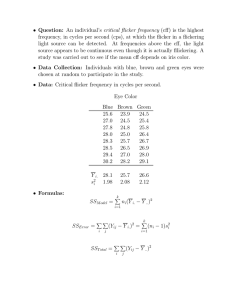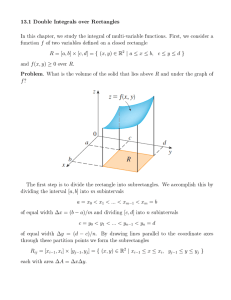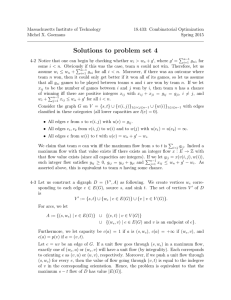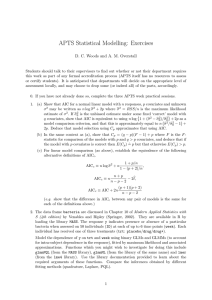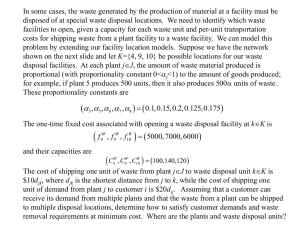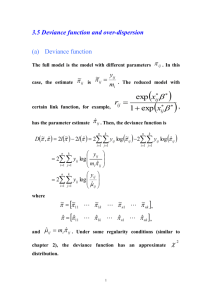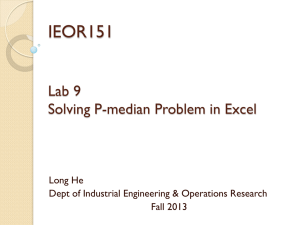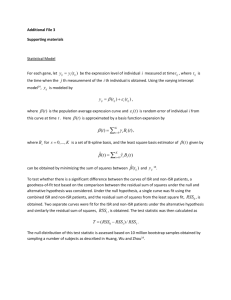INTEGERS 13 (2013) #A53 A NOTE ON IRREGULARITIES OF DISTRIBUTION R. L. Graham
advertisement
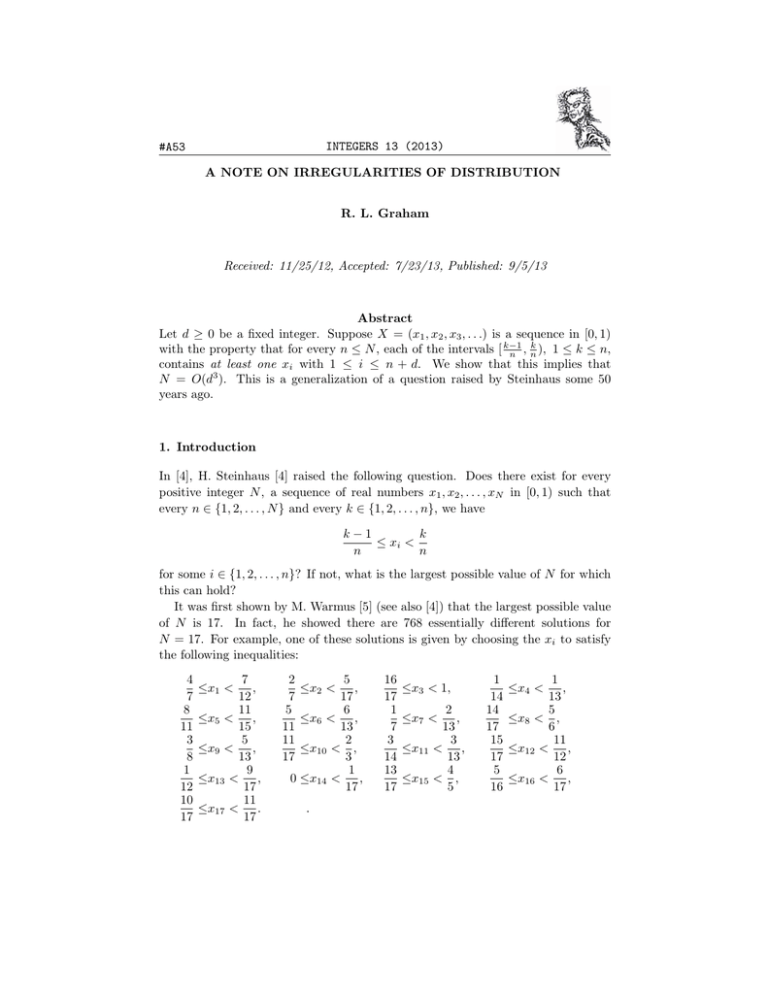
INTEGERS 13 (2013)
#A53
A NOTE ON IRREGULARITIES OF DISTRIBUTION
R. L. Graham
Received: 11/25/12, Accepted: 7/23/13, Published: 9/5/13
Abstract
Let d ≥ 0 be a fixed integer. Suppose X = (x1 , x2 , x3 , . . .) is a sequence in [0, 1)
k
with the property that for every n ≤ N , each of the intervals [ k−1
n , n ), 1 ≤ k ≤ n,
contains at least one xi with 1 ≤ i ≤ n + d. We show that this implies that
N = O(d3 ). This is a generalization of a question raised by Steinhaus some 50
years ago.
1. Introduction
In [4], H. Steinhaus [4] raised the following question. Does there exist for every
positive integer N , a sequence of real numbers x1 , x2 , . . . , xN in [0, 1) such that
every n ∈ {1, 2, . . . , N } and every k ∈ {1, 2, . . . , n}, we have
k−1
k
≤ xi <
n
n
for some i ∈ {1, 2, . . . , n}? If not, what is the largest possible value of N for which
this can hold?
It was first shown by M. Warmus [5] (see also [4]) that the largest possible value
of N is 17. In fact, he showed there are 768 essentially different solutions for
N = 17. For example, one of these solutions is given by choosing the xi to satisfy
the following inequalities:
4
7
8
11
3
8
1
12
10
17
7
,
12
11
≤x5 <
,
15
5
≤x9 <
,
13
9
≤x13 <
,
17
11
≤x17 <
.
17
≤x1 <
2
5
≤x2 <
,
7
17
5
6
≤x6 <
,
11
13
11
2
≤x10 < ,
17
3
1
0 ≤x14 <
,
17
.
16
17
1
7
3
14
13
17
≤x3 < 1,
2
,
13
3
<
,
13
4
< ,
5
≤x7 <
≤x11
≤x15
1
14
14
17
15
17
5
16
1
,
13
5
≤x8 < ,
6
11
≤x12 <
,
12
6
≤x16 <
,
17
≤x4 <
2
INTEGERS: 13 (2013)
A generalization of Steinhaus’ question was treated in 1970 in a paper of E. R.
Berlekamp and the author [1]. Here, for each integer d ≥ 0, we define s(d) to be the
largest integer such that there is a sequence x1 , x2 , . . . , xs(d) with xi ∈ [0, 1) so that
for all n ≤ s(d) − d and all k ∈ {1, 2, . . . , n}, there is at least one i ∈ {1, 2, . . . , n + d}
k
such that k−1
n ≤ xi < n . The result of Warmus shows that s(0) = 17.
In addition to giving a different proof that s(0) = 17, the authors of [1] also
2
presented an argument asserting that s(d) < 4(d+2) for general d. There are several
things to be said about the claim in this paper.
First, the form of this bound already follows (as pointed out in [1]) from a
fundamental inequality of Roth [3]. In particular, he proves the following. Let
X = (x1 , x2 , . . .) be a sequence of points in the interval [0, 1), I ⊆ [0, 1) a subinterval,
|I| its length and Xn (I) the number of xm ∈ I with m ≤ n. Then
�
sup | Xn (I) − n|I| |> c log n
(1)
I⊆[0,1)
for some suitable absolute constant c > 0. This easily implies that s(d) < exp (c� d2 )
for an appropriate absolute constant c� .
The second point to make is that it was recently pointed out by David and Moshe
Newman [2] that the proof given in [1] is incomplete. The purpose of this note is to
fill this gap by a different argument which also yields a much stronger upper bound
on s(d).
2. The Main Result
Theorem 1 There is an absolute constant c such that for all d ≥ 1, s(d) < cd3 .
Proof. (sketch) Fix d ≥ 1 and let X = (x1 , x2 , . . .) be a sequence of points in
k
[0, 1). Let Ik,n denote the subinterval [ k−1
n , n ). Assume that for 1 ≤ n ≤ N, and
1 ≤ k ≤ n, each subinterval Ik,n contains at least one xi with 1 ≤ i ≤ n + d. Our
goal is to show that N = N (d) = O(d3 ). We first want to transform our problem
as follows. Namely, at time n, let us expand the time line by a factor of n. Thus,
the interval Ik,n becomes the (unit) interval Ik = [k − 1, k) and each point xi gets
replaced by nxi . In this form, our condition now is that for 1 ≤ k ≤ n, each of the
intervals Ik contains at least one of the points nxi for some i satisfying 1 ≤ i ≤ n+d.
Furthermore, this must hold for all n satisfying 1 ≤ n ≤ N .
With this interpretation, we can think of each point xi as starting from the origin
at time 0, and then, as time progresses, continuously moving to the right along the
positive time axis with a velocity xi . Let us use the notation xi (t) = txi to denote
the position of xi at time t. Thus, xi (0) = 0 for all i. If we stop the clock at some
integer time n and see where the first n + d points xi (n) are, the hypothesis implies
INTEGERS: 13 (2013)
3
that each of the intervals Ik = [k − 1, k), 1 ≤ k ≤ n, has at least one of these points
in it.
Our proof sketch proceeds as follows. We first choose some (large) time t0 and
identify a (large) set of disjoint pairs of points (yi (t0 ), zi (t0 )), with yi (t0 ) ∈ I4i and
zi (t0 ) ∈ I4i+2 . Thus, the differences gi (t0 ) = zi (t0 ) − yi (t0 ) are bounded between
1 and 3. We will next select d + 1 of these, say gi1 (t0 ), gi2 (t0 ), . . . , gid+1 (t0 ), with
gij (t0 ) = zij (t0 ) − yij (t0 ) which all are close to each other in size, i.e., so that all
|gij (t0 )−gik (t0 )| < α for some small α = α(d). We will then let time advance from t0
to some later time t1 > t0 . This will have the effect of (linearly) expanding the gij (t)
by a factor of roughly tt10 (since yij (t0 ) = t0 yij goes to yij (t1 ) = t1 yij , etc). We will
choose t1 so that all the sizes of the (expanded) differences gij (t1 ) = zij (t1 ) − yij (t1 )
now lie between 3 and 3 + δ for a small δ = δi (d). (Strictly speaking, the differences
should be bounded away from 3, but this does not affect the basic argument). Note
that we can always choose t1 ≤ 3t0 . The next (and final) step is to start letting
the time variable advance, keeping track of where the terms of each pair yij (t) and
zij (t) are as the time variable assumes successive integer values.
Suppose at some time t a particular pair (yij (t), zij (t)) has yij (t) just barely less
than some integer m. That is, at time t, yij (t) ∈ Im = [m − 1, m) but at time t + 1,
yij (t + 1) ∈ Im+1 = [m, m + 1). However, at time t, we still have zij (t) ∈ Im+4
(since gij (t) = zij (t) − yij (t) is just barely greater than 3). By the hypothesis on
the original sequence X, the intervals Im+1 , Im+2 and Im+3 must each also have
points xm (t) in them at time t. However, when we advance the time to t + 1 and
yij (t + 1) now moves out of Im and into Im+1 , its mate zij (t + 1) is still in Im+4
(since gij (t + 1) is still only slightly larger than 3). Consequently, at time t + 1, the
4 intervals Im+1 , Im+2 , Im+3 and Im+4 now have 5 points in them! Furthermore,
the situation persists until the time advances to the point where zij (t) leaves Im+4 ,
which is most of the time that yij (t) is still moving across Im+1 . We will call
these times at which there are 5 x�j s in 4 consecutive Ir� s “good” times for the pair
(yij , zij ). While we don’t know exactly when these various transitions occur for
different pairs, it is enough to show that for a suitable finishing time t2 , the fraction
d
of the number of time steps that are “good” for each pair exceeds the fraction d+1
of the total number of time steps rom t1 to t2 . From this it will follow that there
must be some common time which is simultaneously good for all d + 1 pairs. This is
a contradiction since at this time, we would have d + 1 disjoint sets of 4 consecutive
intervals Ik which each have 5 points xi in them, forcing some other interval Il to
have no point xi in it, contradicting our initial hypothesis.
To make this all work, it is simply a matter of choosing the various parameters
carefully (actually, one doesn’t have to be too careful). For example, we need to
make sure that that the values yi (and zi ) are not too small (since it takes roughly
1
yi time steps for yi (t) to go from m to m+1). We would like this minimum numbers
of steps to cross a unit interval to be relatively large.
INTEGERS: 13 (2013)
4
It turns out that with a modest amount of computation, the following choice of
parameters can be shown to work. Namely, start by taking t = 5000d3 (for example).
We will choose our yi and zi from the intervals I4r to I8r+2 where r = 20d2 . This
will guarantee that we can find d + 1 differences gij (t) = |zij (t) − yij (t)| which differ
1
in size from each other by at most 10d
. We then expand these (by letting time
3
increase to t1 ≤ 3t0 ≤ 15000d ) so that the sizes of all the enlarged gij (t0 ) satisfy
1
3 < gij (t0 ) < 3 + 9d
. Finally, we compute the fraction of time steps which are
“good” time for each difference zij (t) − yij (t) from times t1 to t2 = t1 + 1000d2 .
d
This turns out to be at least the fraction d+1
of the total number of times steps
during time period from t1 to t2 . This in turn implies that there is some time
t during this period which is good for all d + 1 of the differences zij (t) − yij (t),
which is a contradiction. This implies that the initial value of N must be less than
t1 + 1000d2 < 16000d3 and consequently s(d) < 16000d3 (this bound is actually
rather loose). Checking the details is not difficult (although messy) and we leave
this to the interested reader. This completes our proof sketch.
3. Some Remarks
It is not clear what the truth for the upper bound of s(d) really is. Could it actually
be linear in d? Or even sublinear? It would be interesting to know what the correct
growth rate for s(d) is. While it is known that s(1) ≥ 23, we have no nontrivial
estimates for lower bounds for s(d). It would appear that some new ideas may be
needed to attack this problem.
References
[1] E. R. Berlekamp and R. L. Graham, Irregularities in the Distributions of Finite Sequences, J.
Number Th. 2, (1970), 152–161.
[2] David and Moshe Newman (personal communication).
[3] K. F. Roth, On irregularities of distribution, Mathematika 1 (1954), 73–79.
[4] H. Steinhaus, One Hundred Problems in Elementary Mathematics, Basic Books, New York,
(1964).
[5] M. Warmus, A Supplementary Note on the Irregularities of Distributions, J. Number Th. 8,
(1976), 260–263.
